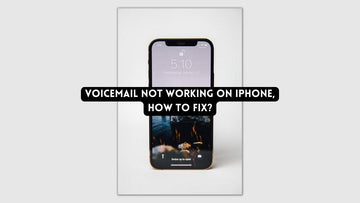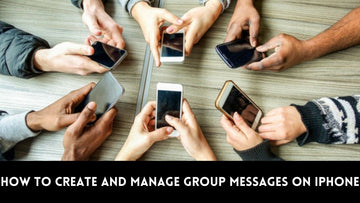Detailed Guide on How to Use Your iPhone as a Webcam on a Mac?
by Chelsea Bruhl on Sep 26, 2024

Do you want to know how to use your iPhone as a webcam on a Mac?
Fortunately, with Continuity Camera, this is possible, and you can even take advantage of the powerful iPhone camera and use that in place of the low-resolution camera on the Mac.
There are two methods you can use: connecting wirelessly or with a USB cable for a wired connection. In this article, I will explain in detail how to use your iPhone as a webcam on your Mac.
Prerequisites
- Before you begin, ensure that your Mac has the latest version of macOS Ventura, and your iPhone has the latest version of iOS 16
- Also, make sure that you have signed in to both devices with the same Apple ID and turned on Wi-Fi and Bluetooth on both devices
- It is also essential to check if your devices meet system requirements. If you are unsure, consult the Apple Support article System requirements for Continuity on Mac, iPhone, iPad, and Apple Watch
- Finally, you need to mount your iPhone and make sure it’s stable
Steps on How to Use Your iPhone as a Webcam on a Mac

Once you have ensured all the prerequisites, you can now use your iPhone as a webcam or microphone. Open any app on your Mac that has access to the camera or microphone, such as FaceTime or Photo Booth.
In the app's menu bar or settings, select your iPhone as the camera or microphone. After that, the Continuity app opens on your iPhone and starts capturing audio or video from the rear camera.

Note that if you want to use your iPhone as a microphone on a Mac without a built-in camera, your iPhone must be in landscape orientation, stationary, and locked.
You can pause or resume the video or audio by tapping Pause or Resume on your iPhone or pressing the side button or Sleep/Wake button to lock it.

To stop using your iPhone as a webcam or microphone, quit the app on your Mac. To remove your iPhone as an option, tap Disconnect on your iPhone.
Your iPhone is removed from the camera and microphone lists in apps and the list of sound input devices in Sound settings. To add your iPhone back, connect it to your Mac with a USB cable.
If you need to charge your iPhone while Continuity Camera is turned on, it is best to use a USB cable for better results.
How to Set your iPhone as the Preferred Camera on Mac?

Your Mac can automatically switch to using the iPhone as a camera input for specific Mac apps like FaceTime and Photo Booth.
To do this, your iPhone must be close to your Mac, have its screen locked, be in landscape orientation, have its rear camera or cameras facing you and be unobstructed, not be in a pocket or lying flat on a desk, and be stationary.
If you have used your iPhone as a webcam on your Mac before, other Mac apps may also remember it as the preferred camera. If not you can follow the steps above on how to use your iPhone camera as a webcam on your Mac to set your preferred choice.
How to Set your iPhone as the Default Microphone on Mac?

You can also make your iPhone the default microphone for your Mac. To do this, select your iPhone in the list of sound input devices in the Sound settings. The Continuity app opens on your iPhone and starts capturing audio.
Here’s what needs to be done;
- Click on the Apple menu icon on your Mac's menu bar.
- Click on "System Preferences." and then tap on "Sound" in the System Preferences window.
- Now click on the "Input" tab and then choose your iPhone from the list of available input devices.
- Adjust the input volume if necessary.
How to Add Video Effects While Using Your iPhone as a Mac Webcam?
When using your iPhone as a Mac webcam, you can enhance your video experience with several video effects and mic modes.
The video effects include Center Stage, Portrait mode, Studio Light, and Desk View. Center Stage uses the Ultra Wide camera to keep you centered in the camera frame even as you move around.

Portrait mode blurs the background to highlight your face, while Studio Light illuminates your face and dims the background without relying on external lighting.
Desk View shows your face and your desk at the same time, making it ideal for creating DIY videos or showing sketches over FaceTime.
To activate these video effects, click on Control Center in the menu bar, then click on Video Effects and select the desired effect.
Note that Center Stage requires an iPhone 11 or later, excluding iPhone SE, while Portrait mode requires an iPhone XR or later, and Studio Light requires an iPhone 12 or later.
Apart from this, you can select a mic mode to enhance the audio quality. Voice Isolation prioritizes your voice and minimizes background noise, such as traffic or barking dogs. Wide Spectrum captures your voice and the sounds around you, such as music or nature.
To select a mic mode, click on Control Center in the menu bar, then click on Mic Mode and choose the desired option. With these video effects and mic modes, you can improve your video and audio quality when using your iPhone as a Mac webcam.
How to Pause, Disconnect or Turn Off iPhone as Webcam on Mac?
If you are using your iPhone as a webcam on your Mac and receive a call, there are several ways to pause or disconnect the video and audio session.
- If you answer the call on your iPhone, the video and audio will automatically pause until you end the call and lock and mount your iPhone.
- If you answer the call on your Mac, the current video and audio session will pause, and you may need to choose your iPhone again in your app once the call ends.

You can also use your app's controls to stop video, mute audio, or end the call, or simply quit the app.
- If you want to resume using your iPhone as a webcam, you will need to unlock your iPhone and lock and mount it again. Alternatively, you can tap the Pause button on your iPhone screen and then tap Resume to continue using it as a webcam.
- If you want to disconnect your iPhone completely, you can tap the Disconnect button on your iPhone screen, move it out of Bluetooth range of your Mac, or simply turn off Continuity Camera.
When you disconnect your iPhone, the current video and audio session will pause, or it may switch to another camera or microphone if available. To add your iPhone back to the camera and microphone lists on your Mac, you will need to plug it in and mount it.

To turn off Continuity Camera altogether and prevent your Mac from recognizing your iPhone as a camera or microphone, go to Settings > General > AirPlay & Handoff on your iPhone and turn off Continuity Camera.
This will prevent your Mac from detecting your iPhone as a webcam, even when it is plugged in and mounted.
What to Do If You Get a Notification that iPhone Has Disconnected from the Wi-Fi?
If you receive a notification that your iPhone has disconnected from Wi-Fi while using Continuity Camera wirelessly, there are a few steps you can take to resolve the issue.
First, it's important to understand that this disconnection is a rare occurrence that happens to the Continuity Camera feature.
When this happens, your iPhone will automatically switch to using its cellular data connection for background networking tasks, such as email and messages. However, this can impact your data usage, so it's important to address the issue promptly.
One solution is to plug your iPhone into your Mac using a Lightning cable. This will ensure a stable and uninterrupted connection between your devices, without relying on Wi-Fi or cellular data. Once your iPhone is connected to your Mac, you can continue to use Continuity Camera as normal.
Alternatively, you can turn off cellular data on your iPhone. This will prevent your iPhone from using its cellular data connection when Wi-Fi is disconnected, and force it to rely solely on Wi-Fi for all networking tasks. To turn off cellular data, go to Settings > Cellular > Cellular Data and toggle the switch to off.
It's worth noting that this disconnection issue is relatively uncommon, and most users should not experience any issues while using Continuity Camera wirelessly.
But if you do encounter this issue, the above solutions should help to resolve it and ensure that you can continue using Continuity Camera without any interruptions.
Troubleshooting Tips while Using Your iPhone as a Webcam for Mac
If you do not see your iPhone in the camera or microphone list in an app or Sound settings, try connecting it to your Mac with a USB cable and check again.

Make sure that your iPhone is an iPhone XR or later and has the latest version of iOS 16, while your Mac has the latest version of macOS Ventura.
If you are still having trouble using your iPhone as a webcam on your Mac, here are some troubleshooting tips you can try:
- Restart your devices: Sometimes a simple restart can fix connectivity issues between devices.
- Check your network connection: Make sure both your Mac and iPhone are connected to the same Wi-Fi network and that the signal is strong.
- Check your Bluetooth connection: Make sure Bluetooth is turned on and both devices are within range of each other.
- Update your software: Make sure your Mac and iPhone are running the latest versions of their respective operating systems.
- Reset your network settings: On your iPhone, go to Settings > General > Reset > Reset Network Settings. This will reset your Wi-Fi and Bluetooth settings.
- Disable any third-party security software: Some security software can interfere with device connectivity. Try disabling any third-party firewalls, antivirus software, or VPNs.
- Try a different USB cable: If you are connecting your iPhone to your Mac via USB, try a different cable to rule out any issues with the cable itself.
Conclusion
Using your iPhone as a webcam on your Mac is a convenient way to take advantage of the powerful camera on your phone and get better video quality in your video calls and recordings.
With the Continuity Camera feature, you can connect wirelessly or via USB cable and easily switch between using your iPhone as a webcam or microphone on your Mac.
Make it a point to follow the steps above to establish a secure connection between your iPhone and your Mac, and test your camera and microphone to ensure they’re working correctly.





